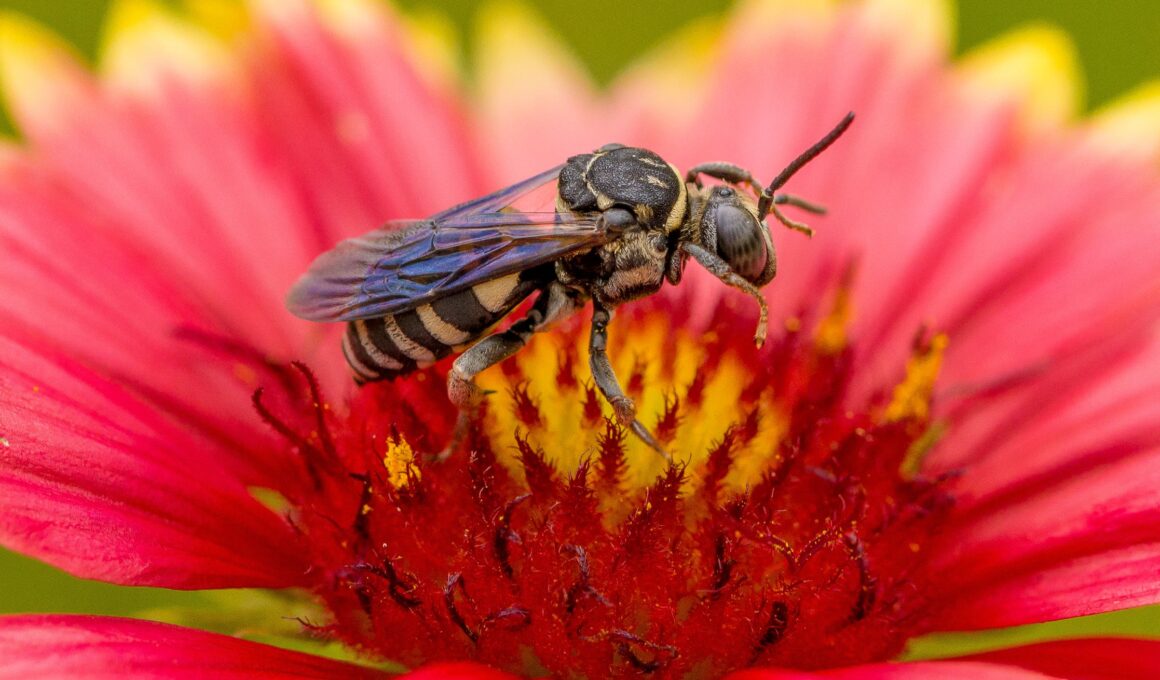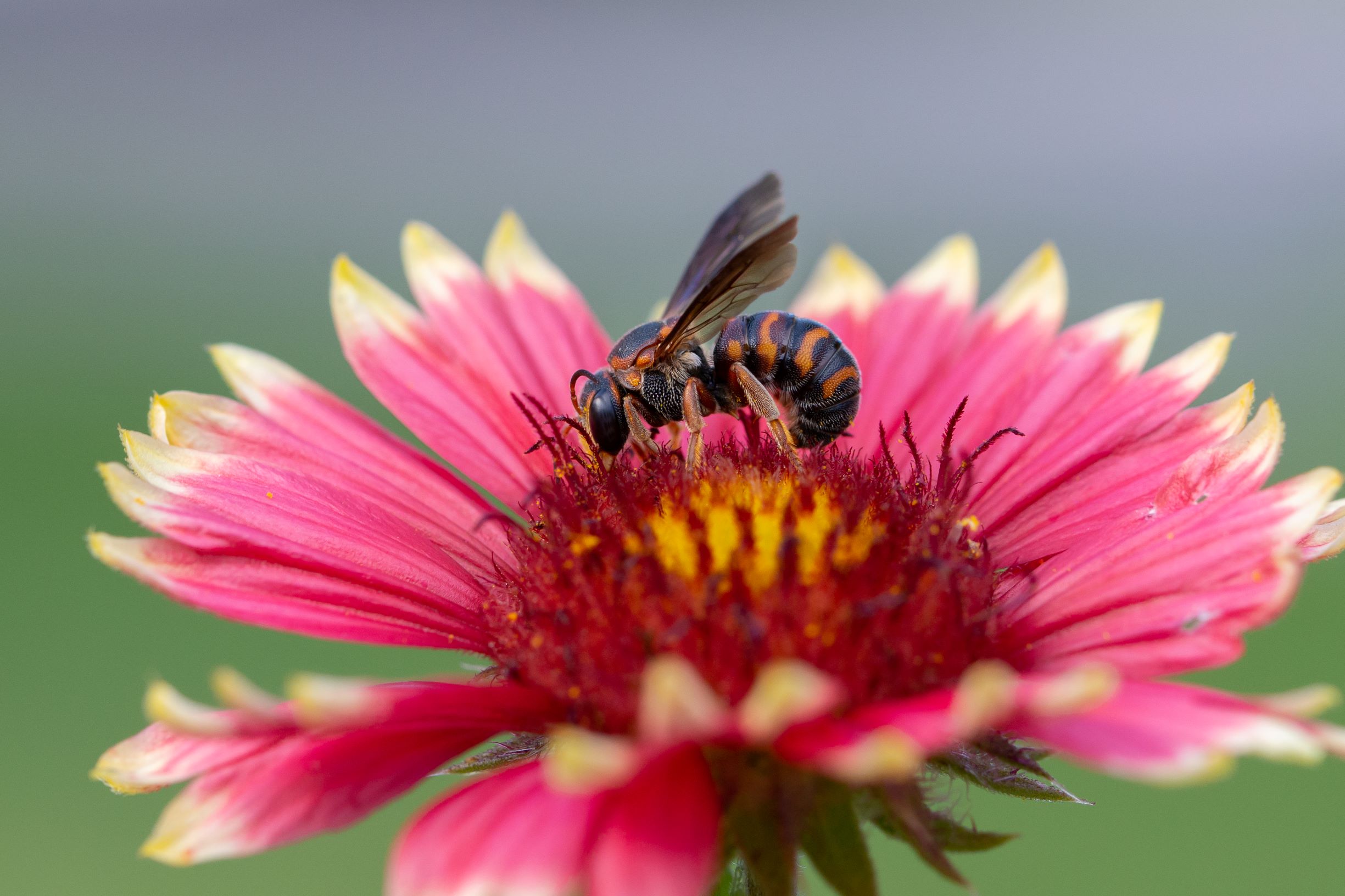
Florida is home to more than 300 of the 4,000 bee species found across North America — including 29 species found nowhere else in the world. Unlike the highly social but non-native honey bees that live in hives, most native bees live solitary lives, and the majority of them nest in the ground.
Story and images by Laura Langlois Zurro; Published April 2021
Native bees are considered a keystone species and are critical for maintaining healthy ecosystems by providing pollination services essential for plant reproduction.
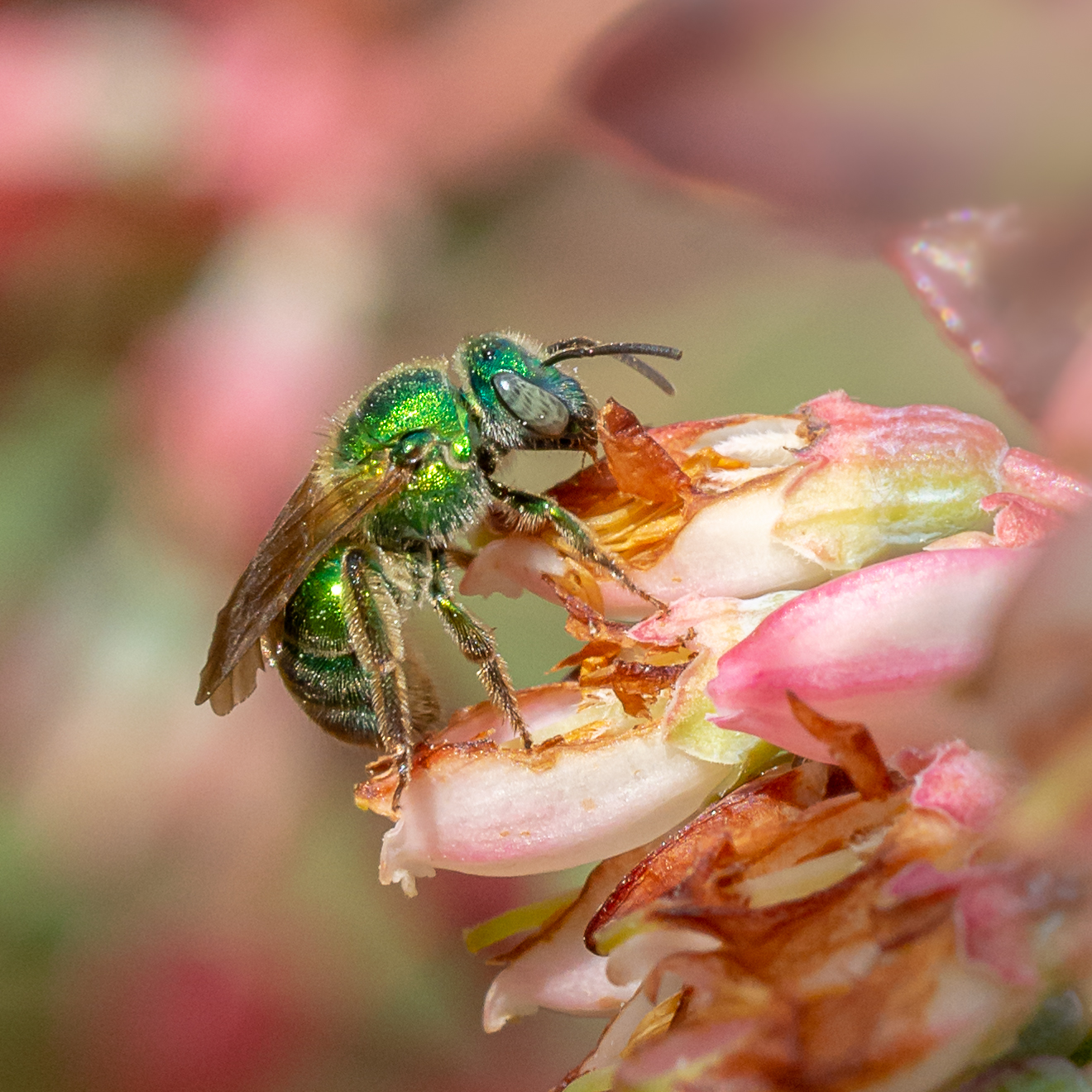
They also play an essential role in crop pollination. If you enjoy blueberries, cucumbers, pumpkins, raspberries or tomatoes – thank native bees for their role in pollinating these foods.
They are all around us – in yards, natural areas, roadside strips, empty lots, and beaches – yet they go mostly unnoticed. They’ve been here for centuries, long before the honey bee was imported to North America by the first European settlers. Unfortunately, like too many native species, Florida’s native bees are threatened by habitat loss and degradation, urban and suburban land development, agriculture, and pesticides.
But gardeners can play an active role in helping them survive by simply adapting their landscaping and lawn practices to meet their needs.
Species Diversity
Unlike non-native honey bees, Florida’s bees are amazingly diverse with six primary families — Andrenidae, Apidae, Colletidae, Halictidae, Megachilidae, and Melittidae. Even within those families, there is tremendous diversity not just within families but within species. They come in all:
- Sizes — smaller than a grain of rice up to the width of a quarter
- Colors — blue/gray, red and black, yellow, orange and black, metallic green, iridescent black, and more
- Fuzziness — from wasp-like with almost no hair to extra fuzziness and
- Shapes — from round to long and slender to extra bulky.
- Even beyond those distinctions, males and females often exhibit sexual differences resulting in some species varying widely in color, shape, and body size based on their sex.
The Importance of Pollen and Nectar

Bees evolved to feed on nectar and pollen. Nectar is rich in sugar, carbohydrates, protein and amino acids. The length of the bee’s tongue plays a role in determining which flower shapes bees can feed on (e.g., flat vs. tubular). Some species, such as sweat bees or leafcutter bees, have short tongues and nectar from flat flowers, while bumblebees have long tongues and prefer tubular shapes.
Pollen is the primary source of protein for bees, particularly for growing larva. Adult females also consume pollen at different times in their life cycle. Bees have evolved to collect pollen on specialized structures called scopa, but how they collect pollen differs. Bumblebees (and non-native honey bees) collect pollen in specialized structures called corbiculae, or pollen baskets, located on their back legs. Other species, such as sweat bees, collect pollen on sticky scopal hairs found on their back legs, while leafcutter bees have scopal brushes located on the underside of their abdomens. Some bees, notably in the Hylaeus family, carry pollen internally.
One type of bee doesn’t even collect pollen – these cleptoparasitic or cuckoo bees are more wasp-like in appearance and lack pollen-collecting hairs. Instead of building nests, they parasitize the nests of other bees by sneaking in when the host is away, laying one or more eggs, and then slipping away. When the egg hatches, it will kill the host larva and eat the pollen.
Nest Behavior
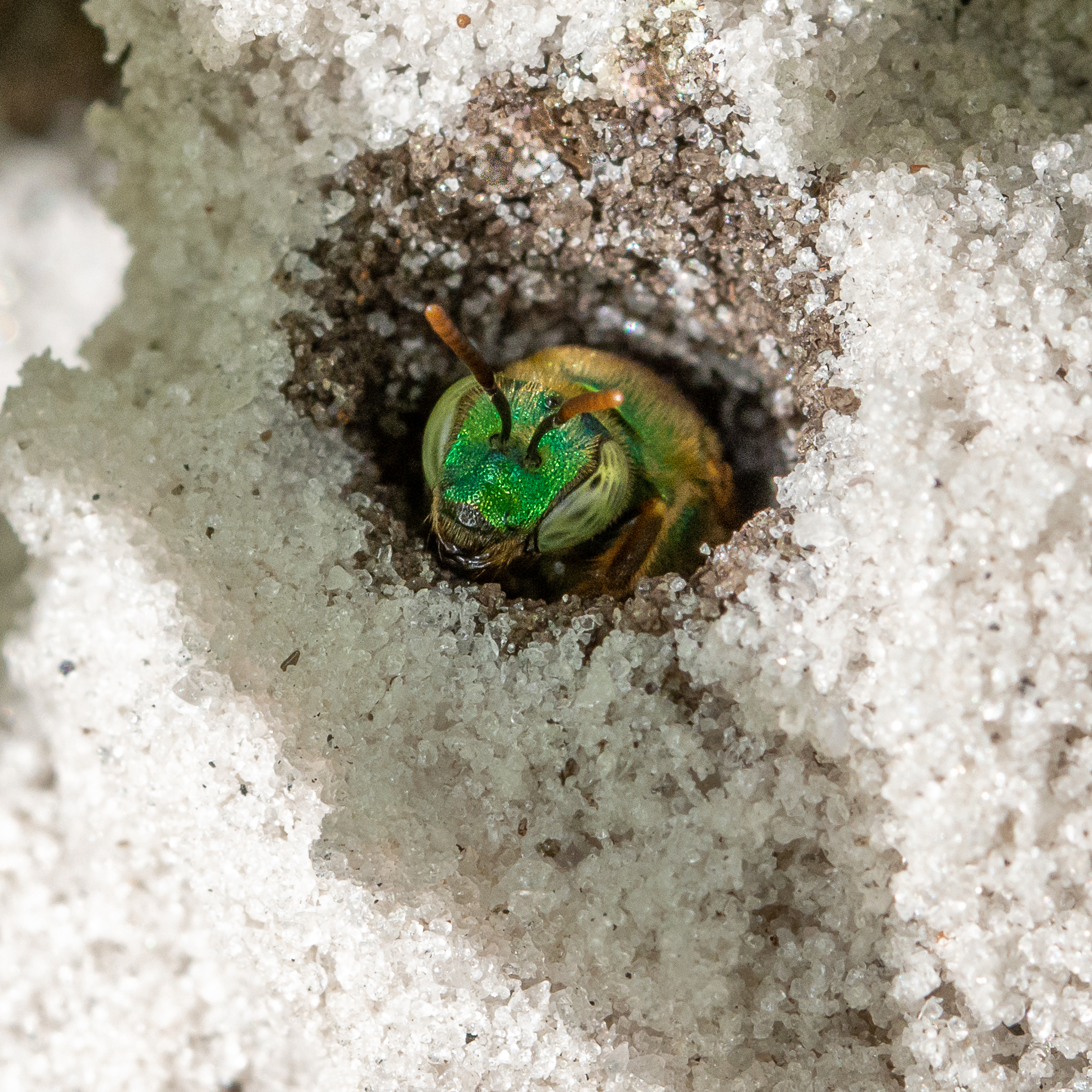
Not all bees nest in hives, in fact, about 80% of the world’s bees live solitary lives, and about 70% of them nest in the ground. Nests often have a raised cone of sand or dirt around the entrance and a small bee-sized hole in the center (typically about the diameter of a wooden pencil). In Florida’s sugar-sand, sometimes it’s just a hole in the ground with no evident soil mound.
Some solitary bee species, such as Colletes, nest in large groups composed of hundreds of individual nests. Female sweat bees practice semi-social nesting behavior with apartment-style nests where they share a common entrance with attached tunnels leading to separate nesting chambers. Although these nests may temporarily change the look of a lawn or garden, they will disappear after a couple of weeks, leaving no trace that they were there.
Approximately 30% of solitary bees don’t nest in the ground. These bees use hollow plant stems, pithy plants, rotting wood, beetle cavities in wood, and some build suspended nests out of resin and pebbles.
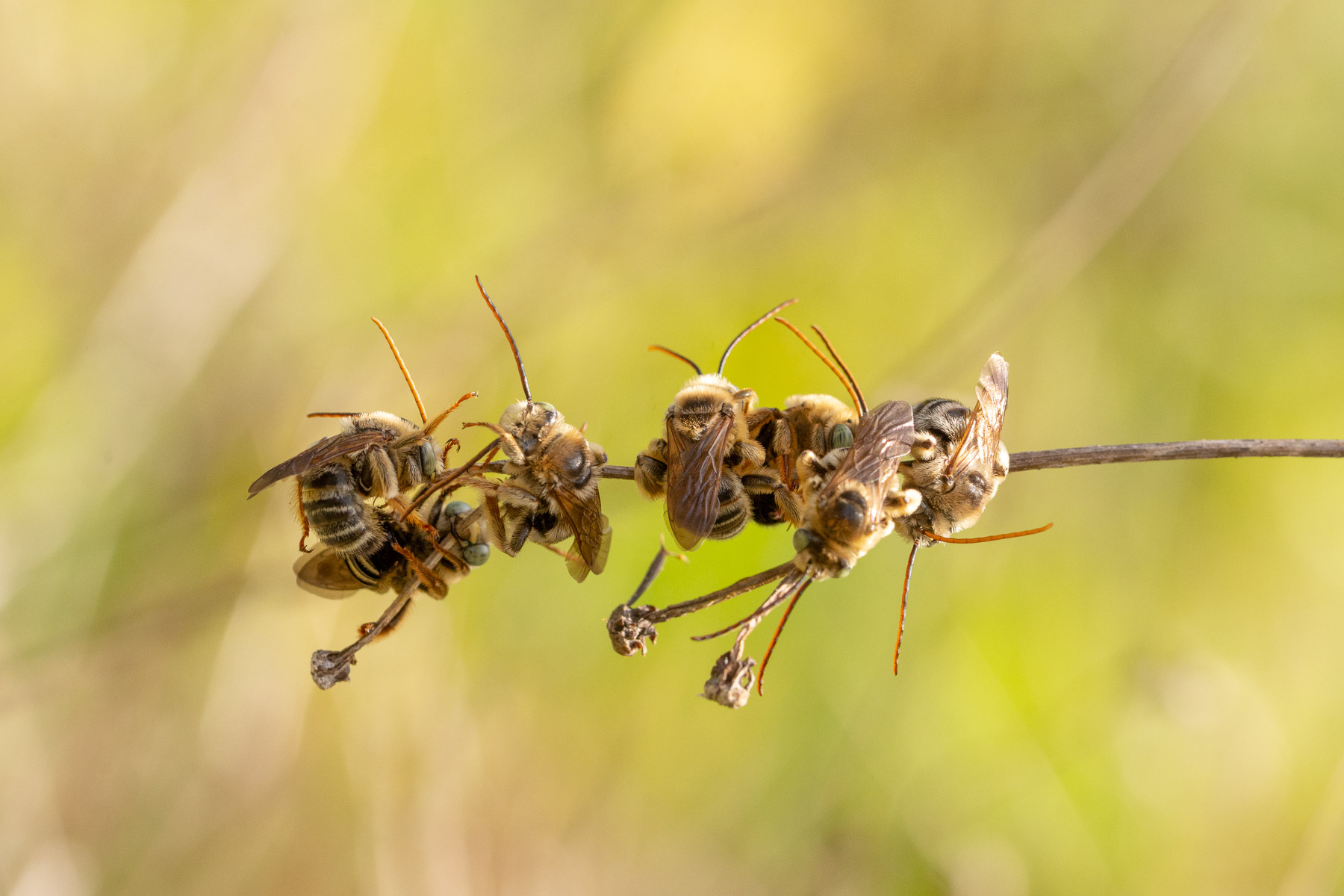
Leafcutter bee nesting behavior varies among species —some nest in the ground, others in cavities or tunnels. Most species line their nest cells with small semi-circular pieces of leaves that they cut with their mandibles, but a few also use flower petals. If you find plants with neat semi-circles missing from leaves or petals, it could be evidence of leafcutter bees. The cuts won’t harm the plants.
Bumblebees are social bees and live in colonies as large as 400 bees. They have an annual life cycle, and each year new queens create new colonies. Bumblebees mainly nest in old rodent burrows or clumps of dried grass, but nests can be found in abandoned bird nests and even furniture. Because the new queens hibernate underground, occasionally they can be dug up during Spring gardening – if you find a hibernating queen, cover her back up.
Now that we know a bit about the secret lives of Florida’s native bees, it’s time to learn how to create a habitat that supports them.
Think Like A Bee

Take a walk through your yard and think like a bee. Are there food sources? Are they easily located? Is there an abundance of flowers in one place, or do you have to fly from section to section just to find flowers? Are they the right color? Is there enough variety and can you access the nectar or pollen easily? Will there be flowers for you no matter what time of year you emerge (Spring, early Summer, late Summer)?
Are there places to nest? If you nest in the ground, can you access the ground, or is there mulch or weed cloth blocking your way? If you nest in stems, are there any available? Will your babies be able to emerge when they are ready to leave the nest? If you’re a male bee, will you have a place to call home as well?
Will you come in contact with pesticides either on the flowers you’re eating, as you move through the plants, or as you create your nests in the ground or other locations?
The following steps can take you from thinking like a bee to providing a safe habitat for bees:
Step 1: What’s On The Menu
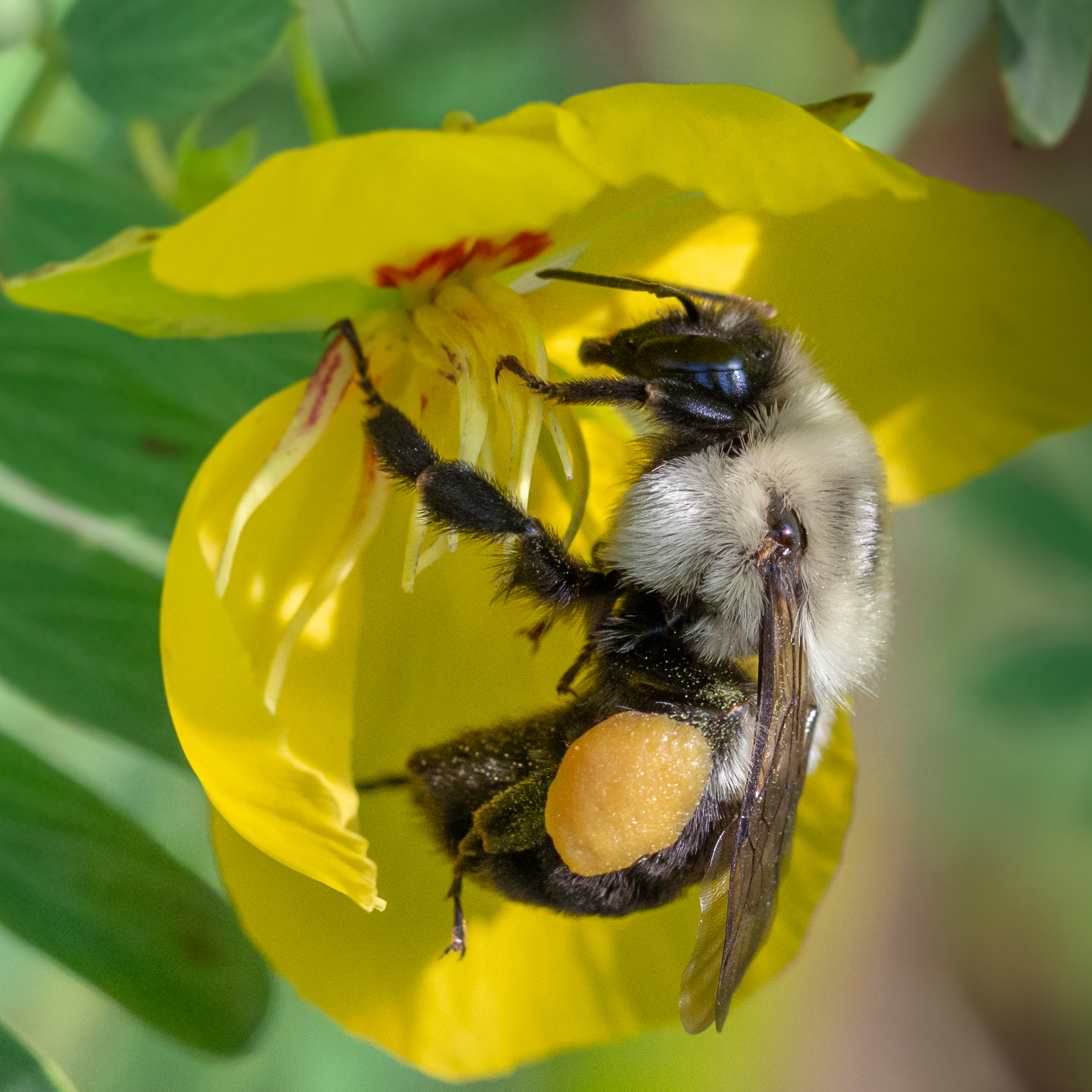
Creating a truly bee-friendly garden requires seeing flowers from a bee’s perspective. The best way to fulfill those needs is to go native and choose wildflowers, and flowering vines, shrubs, and trees. Limit hybrids, cultivars and double-petal flowers that often don’t supply enough nutrients.
Choose white, yellow, or blue-violet flowers because they are more attracted to those colors. Flower size and shape are also important. Plant flat aster-type flowers for short-tongued bees, tubular flowers for long-tongued bees and tiny flowers for the small bees that don’t travel more than a couple of hundred feet from their nests.
Plant in groupings so bees can move easily from flower to flower and plan to have at least three species flowering at all times of the year to accommodate the bees that emerge in different seasons. Once you have planted your garden, try not to disturb it and the nests that bees may have built near their new food source.
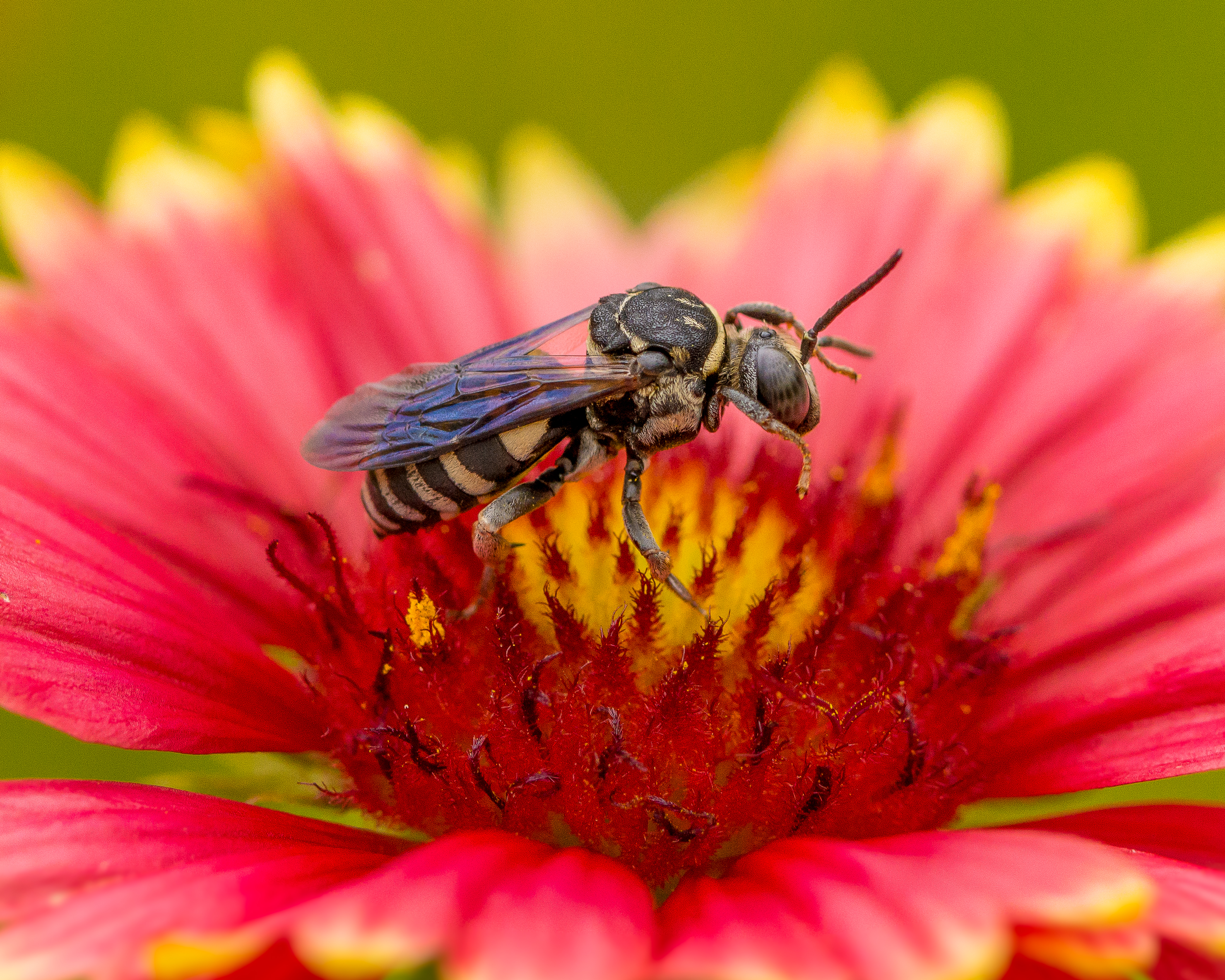
What if you don’t have the space to plant directly in the ground or you rent a home or apartment? Don’t let that deter you. Bees don’t care if the flowers they visit are in the ground or a pot – as long as their needs are met, they will use those plants.
Although there are thousands of flowering plant species across Florida, these ten flowering plants are reliably attractive to bees. Check location, soil type, and moisture levels before making a final choice:
- Goldenrod (Solidago species)
- Asters (Chrysopsis species)
- Blanketflower (avoid cultivars and look for Gaillardia pulchella)
- Dune sunflower (Helianthus debilis)
- Spotted bee-balm (Monarda punctata)
- Beggerticks/Spanish needles (Bidens alba)
- Snow squarestem (Melanthera nivea)
- Sunshine mimosa (Mimosa strigillosa)
- Turkey tangle fog fruit (Phyla nodiflora)
- African blue basil
Step 2: A Place to Call Home
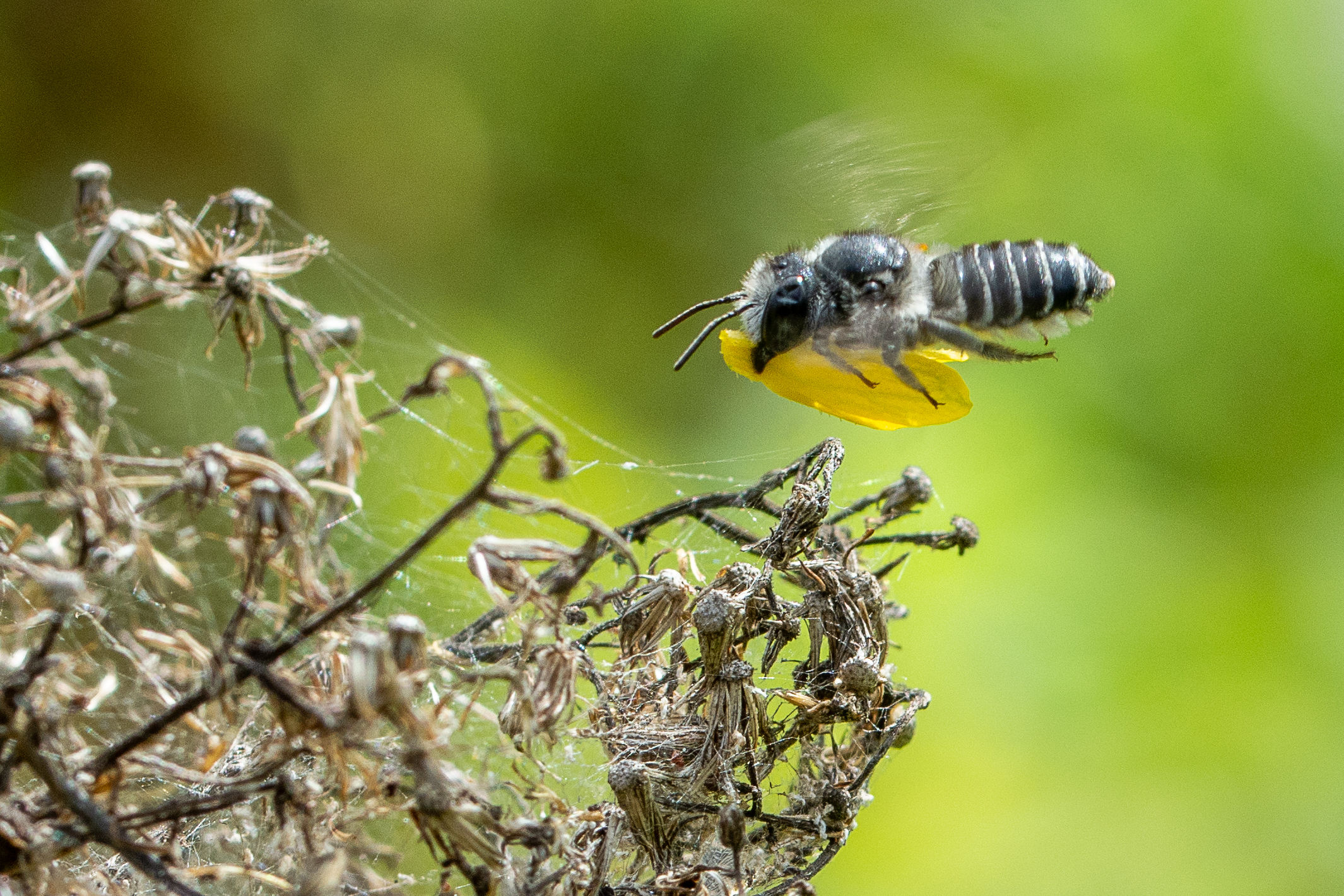
Most ground-nesting bees prefer to nest in sandy areas in full sun, but some species will nest in silty or loamy soils. Skip the mulch and weed cloth, and use pine straw which is loose and allows access to and from the nest. Leave some patches of soil untilled to avoid digging up nests. And if you encounter a suspected nest, avoid stepping on it because the bee will need to locate it and dig the entrance open again when it returns.
Stem-nesting bees also need safe places to nest. Providing them is as easy as leaving plants with hollow or pithy stems standing for at least a year, preferably two. Once the stems are dry, it may still take a bit of time for the bees to discover them and start nesting; leaving them as long as possible will allow the bees to find the dried stems and make their new homes.
Ten plants that can meet the needs of stem-nesting bees are:
- Raspberries (Rubus species)
- Goldenrod (Solidago)
- Swamp milkweed (Asclepias incarnata)
- Dune sunflower (Helianthus)
- Blazing star (Liatris)
- Thistles (Cirsium)
- Bee balm (Monarda punctata)
- Elderberry (Sambucus)
- Roses (Rosa)
- Switchgrass (Panicum virgatum)
If you must cut stems back, be sure to leave 12″-18″ of stem standing. If it is possible, cut the stems very short and then place them in a protected nearby area, away from rain or flooding during storms where they can still be used as habitat.
Another reason to leave some stems standing: Male bees don’t return to the nest once they’ve emerged, but they still need a place to sleep (a.k.a. roost). They can often be found in the evenings or early mornings under aster-type flower heads or clasping the stems of dried-out flower stems with their mandibles. Sometimes males nest in large aggregations of up to 40 or 50 bees. Many male bees geo-locate to the same stem night after night.
Step 3: Host A Bee-Friendly Lawn
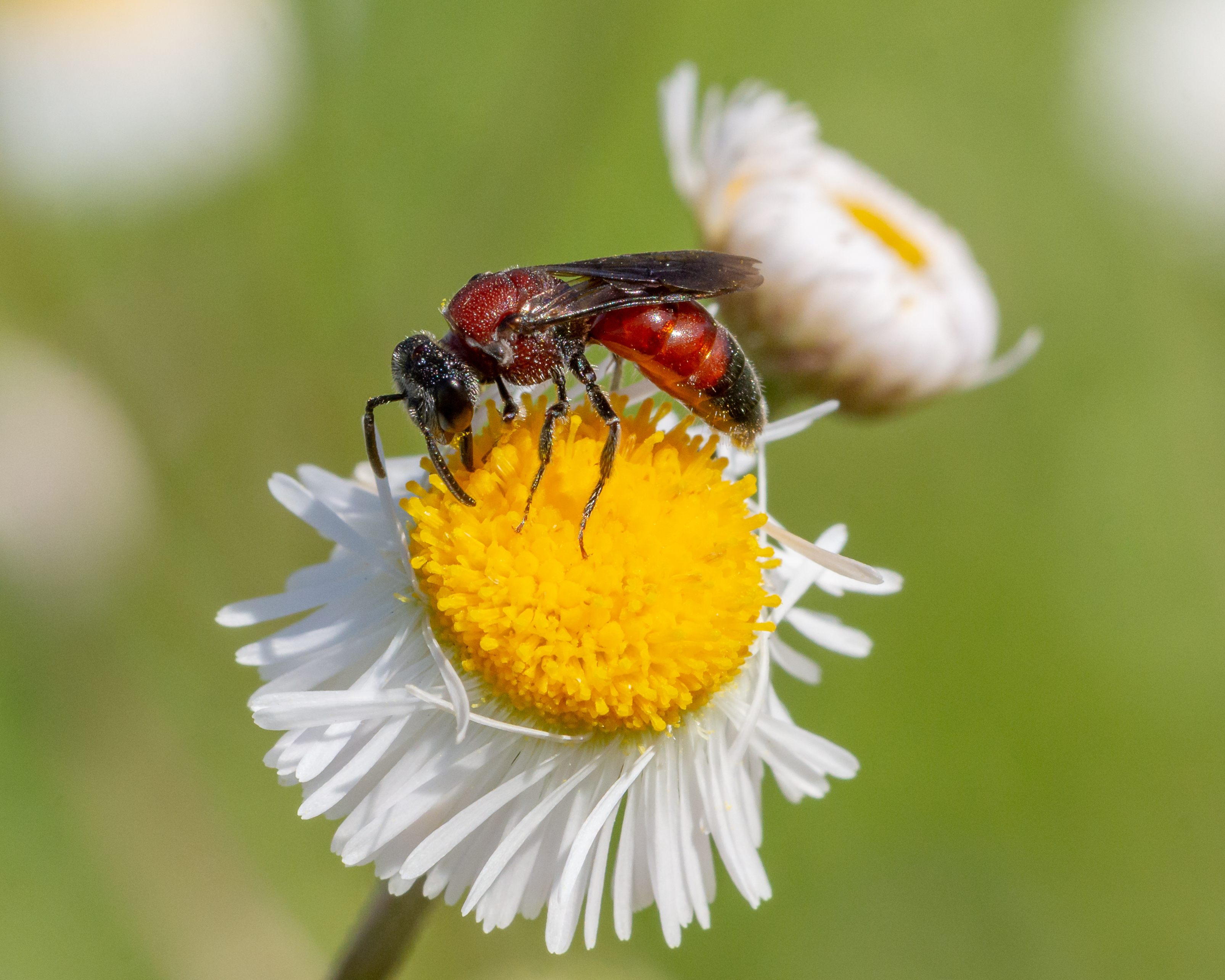
Most lawns are ecological deserts for bees, and with millions of acres of lawns across Florida, even the smallest change can offer big rewards (and will be more sustainable). Rather than mow every week, try to reduce mowing to every second or third week. This will allow small flowers to grow between the grass, providing both food and hiding spots for bees, particularly tiny bees. Spring is the perfect time to do this as wildflowers (e.g., fleabane, spiderwort and coreopsis) pop up in lawns everywhere and provide a great food source for newly emerging bees. Another option is to plant low-growing bee-friendly groundcovers instead of grass – sunshine mimosa or turkey tangle fogfruit are great options. And if you have space, consider converting a small patch of lawn to wildflowers or native grasses.
Step 4: Skip Pesticides
Limit the use of pesticides in your garden and landscape. However benign a product might seem, it can be detrimental to bees, causing immediate death or neurological damage. Insecticides, herbicides and fungicides don’t affect just the target species; they impact your entire ecosystem. The chemicals can leach into the nests of ground-nesting bees. Bees can also ingest pesticides by feeding on plants that have been sprayed or treated with chemical drenches. Even pesticides labeled as organic or safe for bees (e.g., neem oil, soaps or vinegar sprays) can harm bees if they drift onto flowers, the bees themselves, or are carried back to their nests.
Spread the Awareness

Saving Florida’s native bees starts with the awareness that they exist. Now that you know how important they are and what they need to survive, it’s time to get outside and start looking for them. And *bee* sure to let others know about these small but essential denizens of our yards and gardens.
Further Reading:
The Bees in Your Backyard by Joseph Wilson and Olivia Carrill
Bee Basics: An Introduction to Native Bees
Florida Native Bees Facebook Group
To find a native plant nursery, visit PlantRealFlorida.org
Laura Langlois Zurro is the founder of the Florida Native Bees Facebook group. A passionate advocate for Florida’s native bee species, she devotes much of her time to promoting bees in the local community and through social media. She can be found most days in her garden or local protected areas with her camera in hand, documenting bee behavior through observations, photos, and videos to create visual stories that will inspire awareness about native bees.
